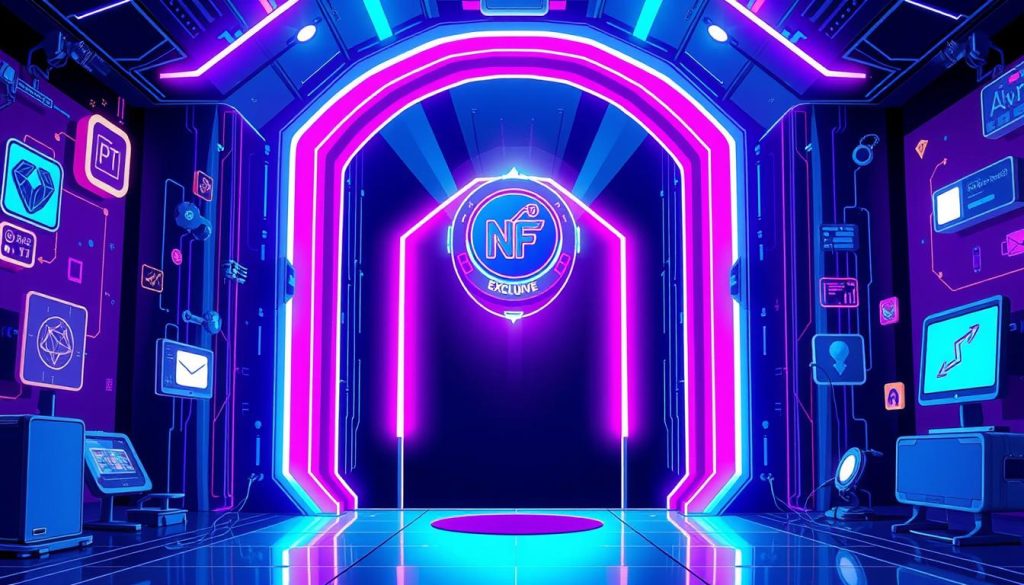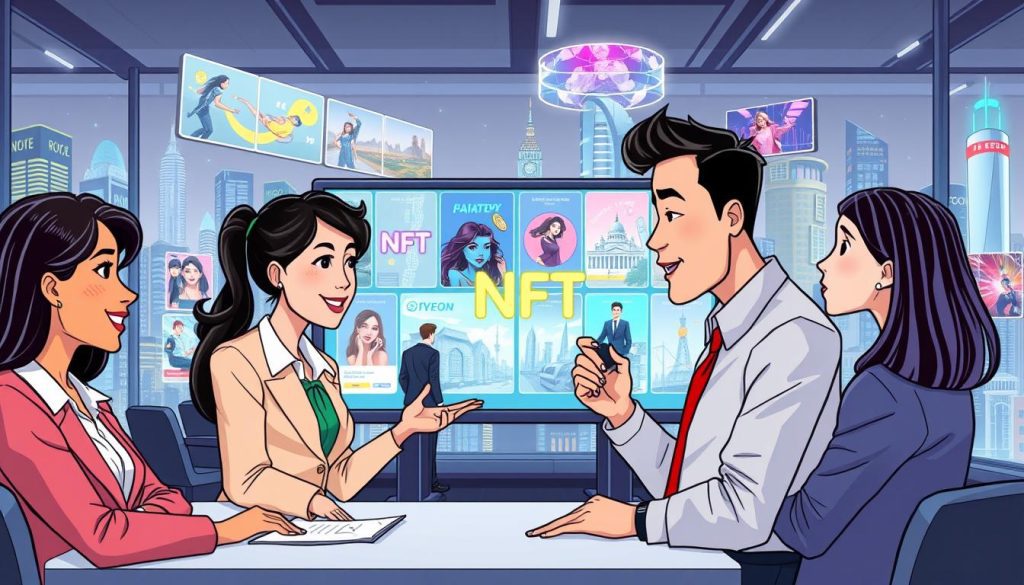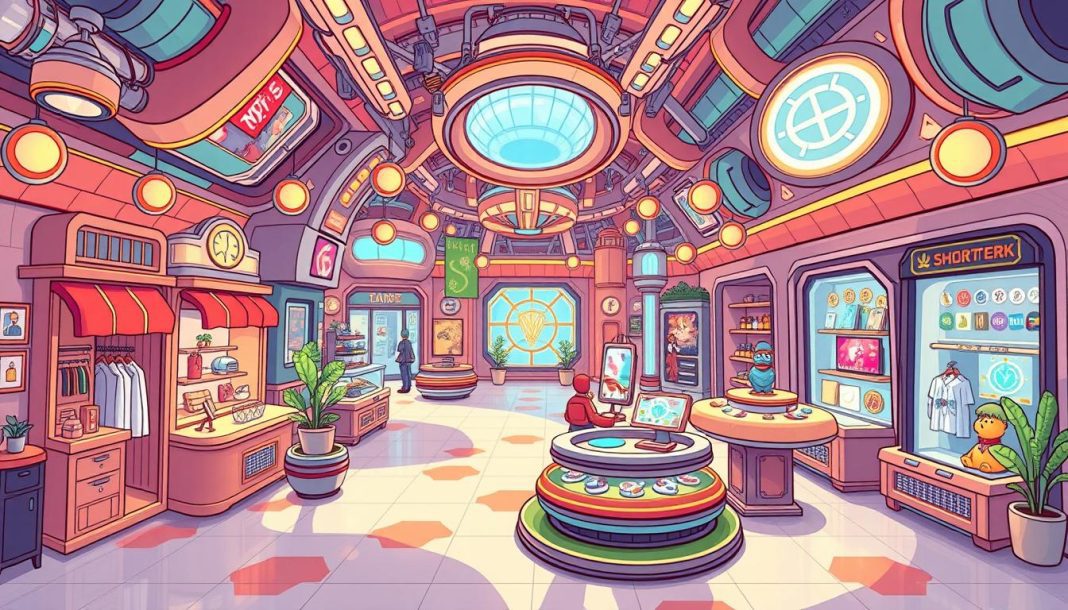NFTs have grown from simple digital collectibles to play key roles in many industries. They are changing how businesses operate, making things more secure, and offering unique experiences. This makes NFTs a big deal for both companies and people who use them.
NFTs are used in many ways, like giving special access and managing supply chains. They help businesses grow and innovate. This shows how NFTs are more than just a trend; they’re a valuable tool for companies to stay ahead.
They also offer exclusive experiences and better security for users. This makes NFTs very appealing to consumers. They are a big part of what makes NFTs useful and exciting.
The Evolution of NFTs: From Digital Art to Functional Assets
NFTs have quickly changed from being just collectibles to something much more. This change is because people want unique digital experiences and new tech is coming out. Functional NFTs are now key, helping businesses give special experiences to their customers.
The rise of nft token-gated access is a big reason for this change. It lets businesses share special content, events, and groups only to those with certain NFTs. This means nft use cases are now in areas like supply chain and finance.
Some examples of nft use cases include:
- Supply chain management: NFTs can track goods’ origin, ownership, and movement.
- Decentralized finance: NFTs can be used as loan collateral, offering new investment options.
- Event access management: NFTs can grant access to exclusive events, like concerts or conferences.

In conclusion, NFTs have grown from digital art to useful assets. This change is driven by the need for unique digital experiences and new tech. As nft token-gated access and functional nfts grow, we’ll see even more nft use cases come up.
Exploring Practical Applications of NFTs in Modern Business
NFTs are changing many industries, like supply chain management and finance. They make things more secure, clear, and efficient. NFTs help businesses make new money and innovate. For example, they help prove a product’s realness and where it came from, making customers trust more.
The newest nft innovations are changing how businesses work. This includes nfts in supply chain management and digital ownership. As NFTs grow, we’ll see even more ways they help businesses. Some ideas include:
- Turning assets into tokens for easier investment
- Creating finance platforms for those who can’t get services easily
- Checking digital identities to keep information safe and prevent theft
As businesses look into NFTs, it’s key to keep up with new ideas. By using nfts in business and nfts in supply chain management, companies can lead the way. They can take advantage of what NFTs offer.

Token-Gated Access: Revolutionizing Digital Membership
Token-gated access is a big deal with NFTs. It lets businesses give special perks to their customers. This way, companies can show their appreciation and build a strong community. It’s changing how we think about digital memberships, making them more personal and exclusive.
One cool thing about token-gated access is exclusive content distribution. Businesses can share special music, art, or videos only to those with tokens. It’s a win-win, offering a unique experience and a new way for businesses to make money. Plus, functional nfts help manage event access, letting token holders into exclusive events.
But there’s more to it than just content and events. It also helps businesses build communities. This makes customers feel like they belong, boosting loyalty and retention. It opens up new ways for businesses to connect with their fans.
- Music festivals offering exclusive content and experiences to token holders
- Online courses providing limited-edition materials and access to expert instructors
- Community-building platforms creating exclusive events and experiences for token holders
These examples show how token-gated access is changing the game. It’s opening up new possibilities for both businesses and customers.
NFTs in Supply Chain Management: Ensuring Authenticity and Traceability
NFTs are changing supply chain management by making products more authentic and traceable. This shows how NFTs can help in many fields, not just art. It’s a big step forward in tracking and verifying products.
One key use of NFTs is giving products unique digital identities. This lets companies track their goods and prevent counterfeits. For example, luxury brands can check if a product is real. Meanwhile, drug companies can track where their medicines come from.
Using NFTs in supply chains brings many benefits. These include:
- Improved authenticity and traceability
- Enhanced supply chain efficiency
- Increased transparency and accountability
As NFTs become more common in supply chains, we’ll see even more uses. They have the power to make things more efficient and innovative. NFTs are set to be a big part of the future in supply chain management.
Decentralized Finance: NFTs as Loan Collateral
NFTs are becoming a big deal in decentralized finance as loan collateral. NFTs in DeFi loans help lenders understand risk and value better. They can represent unique digital assets. This is making nft innovations popular in finance, offering new ways for businesses and people to get capital.
Using functional nfts as collateral has many benefits. They can be checked and moved easily, cutting down fraud risk. Plus, NFTs can stand for many assets, like digital art or real items. This makes them useful for both lenders and borrowers.
Some top examples of NFT-backed lending platforms include:
- Platform A, which offers loans backed by rare digital art
- Platform B, which finances businesses with NFTs as collateral
- Platform C, which lets people borrow against their NFTs
As NFTs in DeFi grow, we’ll see more creative uses. They can represent unique digital assets and make lending safe and efficient. nfts in defi loans are set to be key in finance’s future.
| Platform | Loan Type | Collateral |
|---|---|---|
| Platform A | Digital Art Loan | Rare Digital Art NFTs |
| Platform B | Business Loan | Business-Related NFTs |
| Platform C | Personal Loan | Personal NFT Holdings |
Consumer Applications: Beyond Digital Ownership
NFTs are being used in many ways by consumers, showing their flexibility. They are used for creating unique experiences, like exclusive content and event access. For example, music festivals and online courses give special perks to attendees through NFTs.
Some examples of nfts beyond art include:
- Virtual real estate, where NFTs represent ownership of digital land or properties
- Collectible in-game items, which can be bought, sold, and traded like traditional collectibles
- Exclusive access to events, such as concerts or conferences, where NFTs serve as digital tickets
These uses show how NFTs can change how we interact with brands and artists. As NFT technology grows, we’ll see even more creative uses in the future.
Implementation Challenges and Solutions
Introducing nft innovations comes with its own set of challenges. These include the need for technical infrastructure and understanding regulatory rules. Businesses looking into functional nfts must weigh the costs and benefits of this journey.
Key hurdles include technical infrastructure requirements like blockchain and smart contracts. Also, regulatory considerations are vital, covering intellectual property and consumer protection.
Technical Infrastructure Requirements
To tackle these issues, companies can invest in their tech setup. This includes blockchain and smart contracts. This will help them create and manage functional nfts and discover new uses.
Regulatory Considerations
It’s also important to follow the law. Businesses must make sure they’re meeting legal standards. This includes safeguarding intellectual property and protecting consumers.
Cost-Benefit Analysis
Doing a cost-benefit analysis is key. It helps businesses see if investing in nft innovations is worth it. By comparing costs and benefits, they can decide if adopting functional nfts is right for them.
By facing and solving the challenges of nft innovations, businesses can fully benefit from functional nfts. They can explore new uses and drive innovation and growth.
Future Prospects and Emerging Trends
The future of nft innovations looks very promising. We’re seeing new trends and innovations coming up. Functional nfts are helping businesses find new ways to make money and innovate.
Some areas where we’ll see growth include:
- More people using nft-based platforms and marketplaces
- Nfts being used in more ways than just digital art and collectibles
- New nft-based products and services being developed
The nft market is changing fast. We’ll see new chances and challenges. Nft innovations could change old industries and start new ones. It’s an exciting time for everyone.
The future of nfts is looking good. We’ll see a lot of growth and new uses in the coming years. Nfts beyond art will keep growing, and functional nfts will help drive this progress.
| NFT Innovations | Description |
|---|---|
| NFT-based platforms | Platforms that enable the creation, buying, and selling of nfts |
| Functional NFTs | NFTs that have a specific use case or function, such as access to exclusive content or events |
Conclusion: The Transformative Impact of NFT Technology
NFT (Non-Fungible Token) technology has changed the game, with uses in business and for consumers. It lets people access special content and experiences. It also makes supply chains better by adding authenticity and tracking.
NFTs have grown from just collectible art to useful tools for businesses. They help companies find new ways to make money and connect with their fans. They also bring new chances for lending and investing in DeFi.
The NFT world is growing, and we’ll see more cool uses soon. NFTs will make things better for both consumers and businesses. They will change how we do things in many areas.
But, there are still hurdles like tech issues, rules, and figuring out costs. Yet, NFTs are set to change the digital world a lot. As more people use NFTs, their role in our lives will grow.



 Bitcoin
Bitcoin  Ethereum
Ethereum  XRP
XRP  Dogecoin
Dogecoin  Wrapped SOL
Wrapped SOL